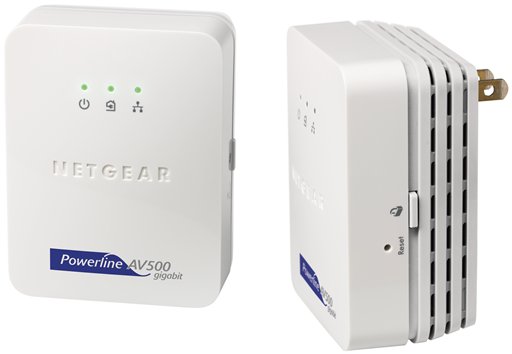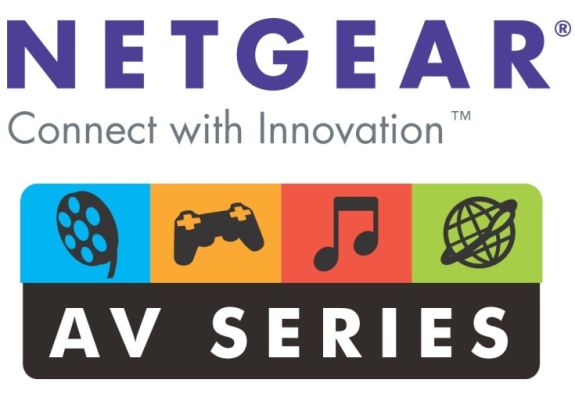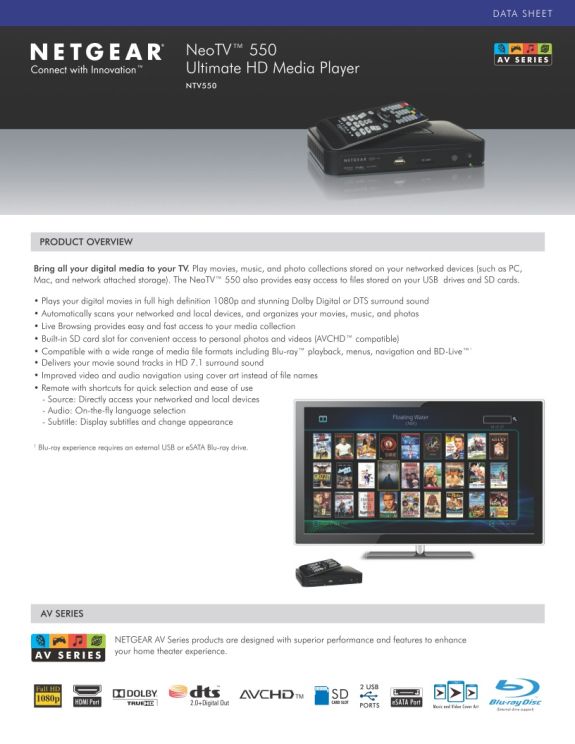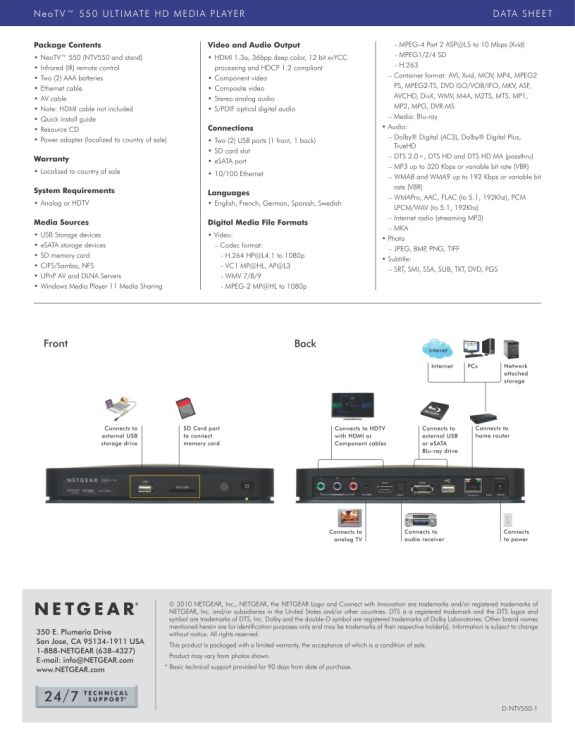Netgear AV Series Set for Expansion
by Ganesh T S on August 25, 2010 4:30 AM ESTThe first half of 2010 saw Netgear get started on their AV Series product line. Their intent was to create a set of products to enhance the consumer's home theater experience. The first few products appeared to be just rebranded versions of already existing units. A case in point is the WNDR3700 802.11n Gigabit router which was rebadged as the WNDR37AV a couple of months back. Rebadged products never generate much enthusiasm, even though Netgear may claim them to be designed with superior performance and features aimed at the home theater market. With Netgear's strength in the networking space, it is no surprise that all the products announced in the AV series so far have been aimed at making sure that the components of a home theater can talk in a satisfactory manner with the Internet, as well as the other components in the home network. However, can any home theater product line ever be complete without a media streamer? Is there any networking methodology (short of running Cat6 cables all over the house) reliable enough for streaming the highest quality Blu-Ray videos?
All this is set to change in the coming months, though. Netgear is slated to bring out a slew of press releases for the upcoming products towards the end of August 2010. In typical AnandTech fashion, we have the official scoop on the details which you are unlikely to find in the press releases.
NeoTV is slated to fill the missing media streamer space in Netgear's AV Series cupboard. Two models are planned, the NTV350 and NTV550. The US market will only see the NTV550, while the European and Australian markets will see both the NTV350 and NTV550. The NTV350 model meant for the non-US market has the same internal feature specifications as that of the WDTV Live (the remote is the same). It is apparently based on a Realtek chipset [Update: Netgear just confirmed that it is based on the RTL 1073]. In this news piece, we will talk about the NTV 550 in detail. The manufacturer's description is provided in the two scans below, for your initial perusal.
In order to differentiate itself from the rest of the media streamers in the market, Netgear has taken the extra step to obtain a license from the Blu-Ray consortium. As far as we know, this is the first media streamer at its price point to get this licensing. This implies that the unit can provide the full Blu-Ray experience, while retaining most of the functionality that the other media streamers provide. The Blu-Ray license comes with a price penalty for the consumer, but we will deal with that later in the piece. After a look at the product brief, AnandTech prepared the usual list of questions that a media streamer enthusiast would have wanted to clarify with Netgear. Some of the details we unearthed are given below:
- The Blu-Ray license guarantees the customer with HD audio passthrough as well as downmix (for Dolby TrueHD, Dolby Digital Plus, DTS-HD MA and DTS-HD HR). There is full support for Blu-Ray-ISO and DVD-ISO (inclusive of menus)
- Netflix will not be supported at the time of release, but it may come as a future firmware upgrade (no guarantees)
- Cover art generation with scraping is supported with a media management software bundled in the accompanying CD
- NFS support exists, but there is currently no plan to put tools in the CD to create NFS shares on a Windows PC
- Netgear has been made aware of the need for commitment to firmware development when dealing with support for the vaguely spec-ed MKV container. 'Advanced' MKV features such as HD audio and PGS subtitle streams are currently being investigated to ensure proper implementation in time for the release.
- The internal chipset has been confirmed to be Sigma Designs 8642 (that was no surprise once we learnt that Netgear had obtained a Blu-Ray license)
The NTV550 is expected to be available for purchase in October 2010 and will be sold at a suggested retail price of US $219.99 (we would really like it to be at a $199.99 price point). Media streamers at comparable prices bring in a slot for an internal hard drive and/or built-in Wireless-N support. The NTV550 has neither, but the Blu-Ray license accounts for the missing features, while maintaining the cost. If you have any further questions prior to the product release, feel free to put them in the comments, and we will get the answers for you.
The other exciting product we are looking forward to is the Powerline AV 500 Adapter Kit (XAVB5001). It was announced at the 2010 CeBit, but we are closer to shipping now, and have more details about the internal chipset.

Just yesterday, we talked about the Atheros 7400 chipset in the review of the WD Livewire, and now we have official confirmation that the AR7400 is indeed powering the whole Netgear AV 500 powerline product line. Netgear was the first to use Intellon's 6400/1400 chipset with the 200 Mbps PHY, and they now seem to have got first dibs with the 7400 chipset also. Netgear claims that the 500 Mbps PHY is getting them 200 - 250 Mbps in the labs. This should result in a real world throughput of at least 100 Mbps. This is more than enough for reliable streaming of a single Blu-Ray stream at its maximum specified bitrate of 54 Mbps (Wouldn't it be nice to see HomePlug AV's claim of being 'HD streaming capable' come true at last?). The Powerline AV 500 Kit (XAVB5001) is slated to hit shelves in late October for a suggested retail price of US $159.
AnandTech will receive the review units in October, and as usual, you can look forward to a really thorough review. If you would like to see anything tested in particular in the media streamer reviews or the powerline adapter reviews, do let us know in your comments. We will definitely revamp our powerline adapter benchmarking methodology, as it is not often that one gets to test out a new generation product in this space.













27 Comments
View All Comments
markk2 - Thursday, August 26, 2010 - link
"Any ideas why the initial reading was so high and then degraded from there?"The only other thing I can think of is microwave ovens and flourescent lights. I found those items to have the most dramatic effect on my network. My AV stuff doesn't seem to create any problems at all.
I guess the lesson here is that some experimentation is needed to get max performance.
bznotins - Wednesday, August 25, 2010 - link
Netgear is pretty notorious for early abandonment of existing products on firmware development. With current MKVs now coming with compressed audio headers, the Netgear EVA-9150 can no longer play the audio on these titles. There hasn't been a firmware release for the 9150 since early 2010 since it is clear the devs are working on the "next best thing". This also happened with the EVA8000 -- firmware development ended there before many of the features on the box were implemented.Netgear makes good media streamers, just know that firmware development isn't their strength or focus.
gwolfman - Wednesday, August 25, 2010 - link
+10 for including full Blu-ray and DVD menu support!!!!!!!!!! :)barry233 - Wednesday, August 25, 2010 - link
Not having Netflix is a killer. I would not bother with any streamer unless it can stream Netflix.chromal - Wednesday, August 25, 2010 - link
You should be sure to include in your testing methodology a means of determining whether this technology emits radio-frequency-interference that would import amateur radio operators on HF (e.g.: shortwave) bands. If it does, it will not be an acceptable consumer electronics product.MGSsancho - Wednesday, August 25, 2010 - link
This is all fine and dandy but until they support features of my aging popcornhour I will not buy it. MKV with subtitle support is a must for me. support all the stuff MKV does well and you have a chance of becoming a show stopper. anything else is an unsold toy.JadedMan - Thursday, August 26, 2010 - link
The video specs look good to me!! One thing I would like to see reviewed is audio support. Lossless audio such as FLAC is important, but also the ability to send an unaltered bit-perfect audio stream through the optical or coax digital audio port. That is important for proper bit-streaming of HDCD encoded rips. I have an outboard DAC that supports HDCD, but a couple of media streamers I've tried do not properly pass through the HDCD encoding. As HDCD is encoded on the least significant bit of the digital audio stream, even minute changes to the audio stream destroy the HDCD encoding. And 24-96 digital audio output via an optical or coax digital audio output would be nice too!jimmyzaas - Thursday, August 26, 2010 - link
Please in your upcoming review of the new Powerline units mention about power protection when using these PowerLine adapters. None of the reviews on current units never mention anything about it. They just mention "oh it works great. it works ok. it's fast. it's slow".. but wait.. what about possibility of frying your delicate home theatre gear?? Mind you, I know all electronics have some small degree of surge protection in them to get that UL rating. It's still concerning.From your WD powerline review, noticed there is a transformer. Is that effectively the surge protection? What about these "noise filters" they implement in Powerline AV+ series? Do these apply to the Ethernet ports as well? Are the noise filters the surge protection? I don't see any MOVs in those.. although I know MOVs are a fire hazard themselves over time.
Linksys units mention they already have surge protection in the units and please do not plug units into a surge protector. It however does not list in specs how many joules, let-through voltage or response time. WTH? Meanwhile, other units like Trendnet tell you specifically to DO NOT CONNECT and DISCONNECT your unit during a thunderstorm. WTH? What sane person would wake up at 3:00am to disconnect these units during a thunderstorm at night?
This is the only thing holding me back from purchasing one of these units. The only other thing I can think of is buying another huge surge protector with ethernet ports.. just for the surge protection.. although I don't think that's very economical. Then there's also the APC ProtectNet standalone surge protector.. but where do I connect the ground? lol.
I worry about this because a few years back, my computer PSU fried during a thunderstorm. Every since, all my equipment are either surge protected or behind a UPS.
I don't think we can take the word of the manufacturer on this.. gotta do some testing.
ganeshts - Thursday, August 26, 2010 - link
Jimmy,All powerline devices sold in the US market have to pass UL certification which looks at the safety regulations.
As far as I know, in the 8 or so years of powerline product shipment, there has been no report of any equipment that has been fried :) I guess manufacturers do run through surge tests on the units, and I will definitely get the exact details from Netgear while reviewing their units.
As for Trendnet's suggestion, just as you are hesitant, they also want to cover their bases. Do you know that is is possible for your DSL modem to get fried due to thunderstorms? In fact, I personally know of people whose DSL modem (as well as the router it was connected to) got damaged due to a thunderstorms in the night time (no one switches them off, as the Internet is considered to be an always-on resource nowadays). Trendnet wants to make you aware of the issue since a fried powerline adapter / router could pose a fire hazard if the consumer tried to use a damaged unit.
scJohn - Thursday, August 26, 2010 - link
HDI has announced 4 new Dune media players that will be available for purchase in Sept. 2010. Seehttp://dune-hd.com/
Looks like steaming media boxes are going to be hot for this Christmas.
Hardware specs mean nothing with out also having quality film-ware and good support for that film-ware. This is the area, film-ware, where the majority of these media device fail. Need I mention the PopBox disaster.
And what's with this ever constant NetFlix coming soon? Can some one break thru the NDA fud and find out what it takes to get NF's seal of approval to run on these media devices. Supposedly the manufacturer has to prove that they will be able to sell 100,000 units the first year, but what else is required.